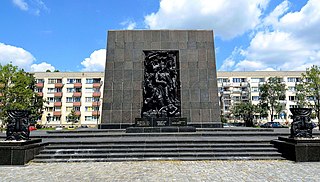Monument to the Ghetto Heroes
Pomnik Bohaterów Getta w Warszawie האנדרטה לזכר מרד גטו ורשה מאָנומענט פֿאַר די געטאָ העלדן אין ווארשע | |
 Monument to the Ghetto Heroes, western side | |
 | |
| 52°14′59″N 20°59′38″E / 52.24972°N 20.99389°E | |
| Location | Muranów, Warsaw, Poland |
|---|---|
| Designer | Nathan Rapoport |
| Material | bronze and stone |
| Beginning date | 1946 |
| Completion date | 1948 |
| Opening date | 16 April 1946 |
| Dedicated date | 19 April |
| Dedicated to | Warsaw Ghetto |
The Monument to the Ghetto Heroes (
The monument was built partly of Nazi German materials originally brought to Warsaw in 1942 by Albert Speer for his planned works. The completed monument was formally unveiled in April 1948.
History and description
The monument was raised in the square bordered by Anielewicza Street, Karmelicka Street, Lewartowskiego Street and

Suzin plaque
The decision to build a monument to the ghetto partisans was made as early as in 1944, by the Central Committee of Polish Jews in Lublin.[1][2] The monument was designed by Leon Suzin.[1][2] The first part of the monument, a small memorial tablet, was unveiled on April 16, 1946; the plaque was in the shape of a circle, with a palm leaf, a Hebrew letter "B" ב, and a Hebrew, Polish and Yiddish inscription: "For those who fell in an unprecedented and heroic struggle for the dignity and freedom of the Jewish people, for a free Poland, and for the liberation of mankind. Polish Jews".[1][2] It was also decided to build a larger monument in the future.[2]
Rapoport monument
The new, larger monument, sculpted by Nathan Rapoport (who worked under the supervision of Suzin), was unveiled on April 19, 1948.[2][3] The monument stands 11 meters (36 ft) tall.[2] As Rapoport himself explained, the "wall" of the monument was designed to evoke not just the ghetto walls, but also the Western Wall ("Wailing Wall") in Jerusalem. The great stones would thus have "framed the memory of events in Warsaw in the iconographic figure of Judaism's holiest site".[4] The labradorite stone used in parts of the monument comes from German supplies, ordered by Albert Speer in 1942 for planned Nazi German monuments.[2]
The western part of the monument shows a


The eastern part of the monument shows the persecution of Jews at the hands of the Nazi German oppressors.[2] The monument has a three-language sign: "Jewish nation to its fighters and martyrs."[2]
The
The
References
Footnotes
Citations
- ^ a b c d "The First Warsaw Ghetto Heroes Monument (Anielewicza St./ Zamenhofa St.)". Virtual Shtetl. Museum of the History of Polish Jews. sztetl.org.pl. Retrieved 2018-02-21.
- ^ a b c d e f g h i j k Szczepan-Wojnarowska, Anna. "Pomnik Bohaterów Getta przy ul. Zamenhofa - Miejsca martyrologii - Zabytki - Warszawa - Wirtualny Sztetl". Sztetl.org.pl. Retrieved 2012-12-08.
- ISBN 9780300112344
- ^ Young, James E. The Texture of Memory, Yale 1993, p. 171
- ISBN 978-0-521-85096-4.
- ISBN 978-0-19-926598-5. Retrieved 8 December 2012.
External links
- Entry on the monument at sztuka.net, includes a gallery
